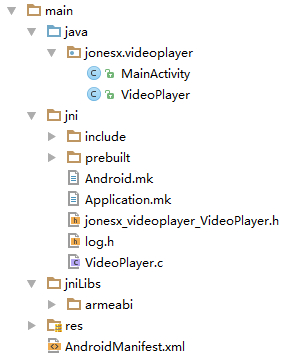Android+FFmpeg+ANativeWindow视频解码播放
- 准备工作
- 编译FFmpeg
- 开发环境
- 建立videoplayer工程
- 建立AS工程
- 实现解码播放
- 运行结果
- 本例工程下载videoplayer
准备工作
1.编译FFmpeg
下载最新版的FFmpeg,具体编译步骤参考文章:FFmpeg的Android平台移植—编译篇。
对于FFmpeg不太了解的可以先阅读雷霄骅的FFmpeg博客专栏。
2.开发环境
Windows 10
Android Studio 1.4
android-ndk-r10d
FFmpeg 3.0
具体的环境配置这里不细讲,可参考Android Studio + NDK的环境配置。
建立videoplayer工程
本文章仅介绍视频播放部分,不包含音频播放,音频播放参见Android+FFmpeg+OpenSL ES音频解码播放。
1.建立AS工程
本文采用直接从SD卡中读取视频文件进行播放,因此在AndroidManifest.xml文件中添加权限:
<uses-permission android:name="android.permission.READ_EXTERNAL_STORAGE" />Android的java API中的GLSurfaceView和VideoView都是继承于SurfaceView的,因此本例中仅在content_main.xml中添加了一个SurfaceView控件:
<SurfaceView
android:id="@+id/surface_view"
android:layout_width="match_parent"
android:layout_height="match_parent" />紧接着在MainActivity.java中获取并操作该控件:
SurfaceHolder surfaceHolder;
@Override
protected void onCreate(Bundle savedInstanceState) {
super.onCreate(savedInstanceState);
setContentView(R.layout.activity_main);
... ...
SurfaceView surfaceView = (SurfaceView) findViewById(R.id.surface_view);
surfaceHolder = surfaceView.getHolder();
surfaceHolder.addCallback(this);
}下面将实现SurfaceHolder.Callback接口:
@Override
public void surfaceCreated(SurfaceHolder holder) {
new Thread(new Runnable() {
@Override
public void run() {
VideoPlayer.play(surfaceHolder.getSurface());
}
}).start();
}
@Override
public void surfaceChanged(SurfaceHolder holder, int format, int width, int height) {
}
@Override
public void surfaceDestroyed(SurfaceHolder holder) {
}视频播放为耗时操作,为了不阻塞UI线程,需要新建线程播放视频。VideoPlayer类的具体实现为:
public class VideoPlayer {
static {
System.loadLibrary("VideoPlayer");
}
public static native int play(Object surface);
}在VideoPlayer类中需要加载动态库,并将play方法声明为本地方法。由于本例仅仅是一个简单的视频解码播放的例子,因此并未添加过多的方法。在play方法的参数中不能使用Surface类,因为这个类不是java类库中的,使用javah命令无法生成相应的头文件,因此需要使用Object基类。现在可以使用javah命令生成头文件:jonesx_videoplayer_VideoPlayer.h。
2.实现解码播放
首先按照文章FFmpeg的Android平台移植—编译篇中的步骤:
新建jni目录,并将编译好的FFmpeg目录中的include和prebuilt文件夹拷贝到jni目录下。
在VideoPlayer.c文件中实现视频的解码播放:
#include "jonesx_videoplayer_VideoPlayer.h"
#include "libavcodec/avcodec.h"
#include "libavformat/avformat.h"
#include "libswscale/swscale.h"
#include 至于stride的问题可以参见android ffmpeg bad video output。
现在需要编写Android.mk文件:
LOCAL_PATH := $(call my-dir)
include $(CLEAR_VARS)
LOCAL_MODULE := avcodec
LOCAL_SRC_FILES := prebuilt/libavcodec-57.so
include $(PREBUILT_SHARED_LIBRARY)
include $(CLEAR_VARS)
LOCAL_MODULE := avformat
LOCAL_SRC_FILES := prebuilt/libavformat-57.so
include $(PREBUILT_SHARED_LIBRARY)
include $(CLEAR_VARS)
LOCAL_MODULE := avutil
LOCAL_SRC_FILES := prebuilt/libavutil-55.so
include $(PREBUILT_SHARED_LIBRARY)
include $(CLEAR_VARS)
LOCAL_MODULE := swresample
LOCAL_SRC_FILES := prebuilt/libswresample-2.so
include $(PREBUILT_SHARED_LIBRARY)
include $(CLEAR_VARS)
LOCAL_MODULE := swscale
LOCAL_SRC_FILES := prebuilt/libswscale-4.so
include $(PREBUILT_SHARED_LIBRARY)
include $(CLEAR_VARS)
LOCAL_SRC_FILES := VideoPlayer.c
LOCAL_LDLIBS += -llog -lz -landroid
LOCAL_MODULE := VideoPlayer
LOCAL_C_INCLUDES += $(LOCAL_PATH)/include
LOCAL_SHARED_LIBRARIES:= avcodec avformat avutil swresample swscale
include $(BUILD_SHARED_LIBRARY)由于没有用到device和filter库中的方法,因此并未连接这两个动态库。
Application.mk文件如下:
APP_ABI := armeabi
APP_PLATFORM := android-9经过ndk-build之后,整个工程的主要目录结构如下图所示:

3.运行结果
为了使工程能够运行,还需要在build.gradle文件中添加一行代码:
android {
... ...
sourceSets.main.jni.srcDirs = []
... ...
}本例使用的Android设备是Google nexus 7,最终的测试结果如下图所示:
注意本例并不是一个真正的视频播放器,因为并没有添加音频播放,以及播放控制操作;也没有对视频的播放速度进行控制,每解码一帧就直接渲染到SurfaceView上。